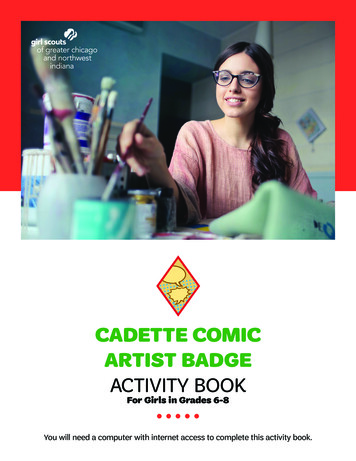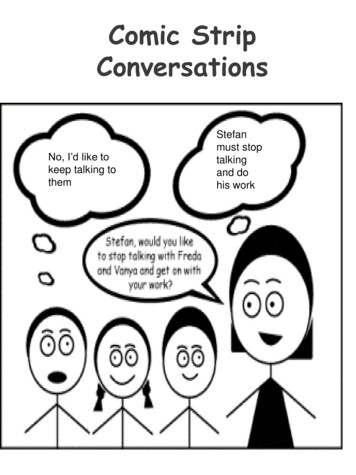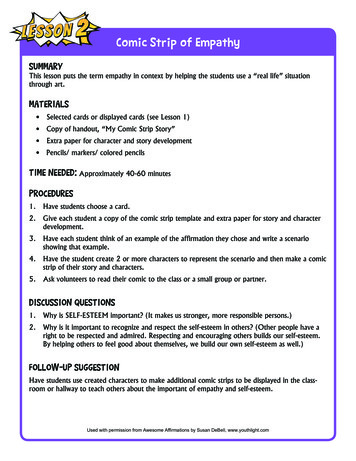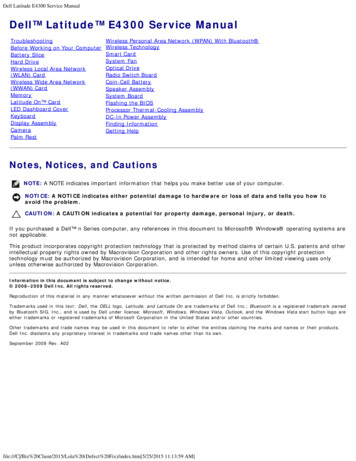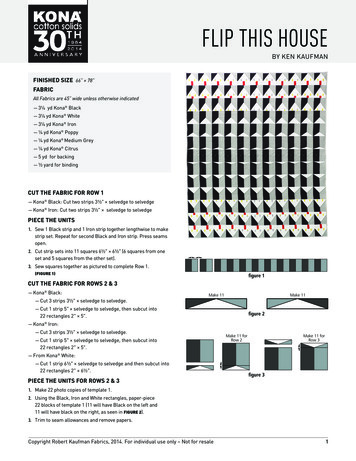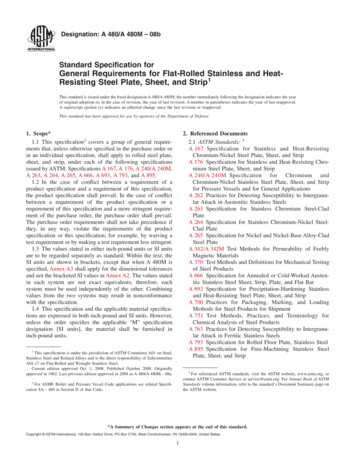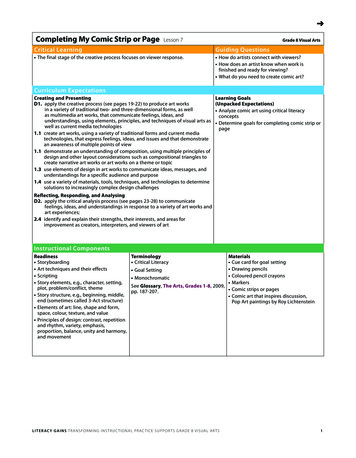
Transcription
Completing My Comic Strip or PageLesson 7Grade 8 Visual ArtsCritical LearningGuiding Questions The final stage of the creative process focuses on viewer response. How do artists connect with viewers? How does an artist know when work isfinished and ready for viewing? What do you need to create comic art?Curriculum ExpectationsCreating and PresentingD1. apply the creative process (see pages 19-22) to produce art worksin a variety of traditional two- and three-dimensional forms, as wellas multimedia art works, that communicate feelings, ideas, andunderstandings, using elements, principles, and techniques of visual arts aswell as current media technologies1.1 create art works, using a variety of traditional forms and current mediatechnologies, that express feelings, ideas, and issues and that demonstratean awareness of multiple points of view1.1 demonstrate an understanding of composition, using multiple principles ofdesign and other layout considerations such as compositional triangles tocreate narrative art works or art works on a theme or topic1.3 use elements of design in art works to communicate ideas, messages, andunderstandings for a specific audience and purpose1.4 use a variety of materials, tools, techniques, and technologies to determinesolutions to increasingly complex design challengesLearning Goals(Unpacked Expectations) Analyze comic art using critical literacyconcepts Determine goals for completing comic strip orpageReflecting, Responding, and AnalysingD2. apply the critical analysis process (see pages 23-28) to communicatefeelings, ideas, and understandings in response to a variety of art works andart experiences;2.4 identify and explain their strengths, their interests, and areas forimprovement as creators, interpreters, and viewers of artInstructional ComponentsReadiness Storyboarding Art techniques and their effects Scripting Story elements, e.g., character, setting,plot, problem/conflict, theme Story structure, e.g., beginning, middle,end (sometimes called 3-Act structure) Elements of art: line, shape and form,space, colour, texture, and value Principles of design: contrast, repetitionand rhythm, variety, emphasis,proportion, balance, unity and harmony,and movementTerminology Critical LiteracyMaterials Cue card for goal setting Drawing pencils Goal Setting Coloured pencil crayons Monochromatic MarkersSee Glossary, The Arts, Grades 1-8, 2009, Comic strips or pagespp. 187-207. Comic art that inspires discussion, Pop Art paintings by Roy LichtensteinL i t e r ac y G a i n s T r a n s f o r m i n g I n s t r u c t i o n a l P r a c t i c e S u pp o r t s G r a d e 8 V i s ua l A r t s1
Completing My Comic Strip or PageLesson 7Grade 8 Visual ArtsMinds OnPairs Reviewing Art TechniquesIn a Gallery Walk, pairs label clear, effective examples of the 15 techniques in comics on ‘OurComic World Wall’ using sticky notes. Facilitate a discussion of techniques: What elements andconventions of the art form are used in this work? How are the elements organized, combined, or arranged? What impact do these have on readers?Students complete the right-hand column of the Exploring Art Techniques Handout.Whole Group Judging CompletionDisplay examples of thumbnails, rough pencilling, fine pencilling, inking and completed work.Ask: How will you know when you’re finished? Discuss qualities of a finished work.Review the comic strip/panel rubric and success criteria. Each student sets one rubric-specificgoal for studio time, writing this on a cue card and taping to the work surface.Action!Individual Using Studio TimeStudents complete the final, monochromatic version of their comic strip or page. Materials and tools may differ, e.g., students can work from a photocopy of their originalstoryboard, redraw their storyboard, use technology to re-create their storyboard; students may use drawing pencils, a coloured pencil crayon or marker. Photocopy or scan the original storyboard so students can experiment with different media and colour choices on copies. They hand in of these as final work.Provide tips for studio time to help students with their final comic strip or page and poseguiding questions: How well are my choices working? How close am I to my goal? What other strategies or approaches might move me closer to my goal? What might I keep or change?Conference briefly with students as they work. Include discussion of prompts related to the Exit Card and artist statement (Lesson 8), e.g.,Pause and PonderQuickTip(1) Prepare question promptsfocusing on a principle ofdesign, as in Balancing Act!Think Literacy SubjectSpecific Examples: VisualArts, Grades 7-12, pp. 8-9.(2) If students have access to theInternet, they can investigatewebsites, videos and blogsby comic artists in order todevelop awareness of howartists connect with audiences.(3) Short, online videos of thecomic art creative process maysupport this discussion. Checkpoint #5Assess storyboards againstsuccess criteria in the rubric.Provide feedback to individualsas they work. Encouragestudents to self-assess and makedesign decisions accordingto success criteria on anchorcharts and comic strip/panelrubric.Students self-select a sourceof story inspiration. What is your rubric-related goal for today? How close are you to achieving this goal? What might a viewer not understand about this work? How might you ensure that thereader receives the information he/she needs? What is one challenge you are experiencing? How are you trying to solve it?ConsolidationIndividual Reflecting on Comic ArtStudents complete an Exit Card and submit it with their completed comic strip/panel. Referexplicitly to success criteria/anchor charts/rubric for writing the artist statement. What is one of your goals with respect to this artwork? How have you tried to achieve this goal? What might a viewer not understand about this work? Why not? What is one challenge you experienced? How did you try to solve it?L i t e r ac y G a i n s T r a n s f o r m i n g I n s t r u c t i o n a l P r a c t i c e S u pp o r t s G r a d e 8 V i s ua l A r t sCheckpoint #2Provide feedback on artiststatement success criteria.Students and the teacheruse the Script FeedbackHandout, Lesson 3 to respondto classmates’ drafts.2
Completing My Comic Strip or PageLesson 7Grade 8 Visual ArtsMinds On Gallery WalkA Gallery Walk is a flexible strategy for having students respond to a range of texts. In a Gallery Walk, studentsexplore multiple texts posted around the room. Texts can include: print, images, historical and contemporary texts,draft or completed texts, professional or student texts.Often, this activity is cooperative and structured by question prompts that require students to observe, discuss, and reflect. Because students move physically, it can appeal to kinaesthetic learners and provide variety in classroom activity. The activity can be used at various points in the lesson, e.g., as a community builder, a warm-up, source of debate, or consolidation activity. The debriefing focuses on key ideas and synthesizingobservations, responses, and thinking.To ensure that ‘Our Comic World Wall’ is a rich source of texts encourage students to continue to post examples from their own experience.Success CriteriaCo-creation of rubrics and analysis of exemplars contribute to transparency and building shared understanding ofcriteria and standards. This work also supports development of peer and self-assessment skills.“Assessment for learning and assessment as learning also require that students and teachers share a commonunderstanding of what constitutes success in learning. Success criteria describe in specific terms what successfulattainment of the learning goals looks like. When planning assessment and instruction, teachers, guided by theachievement chart for the particular subject or discipline (see Chapter 3), identify the criteria they will use to assessstudents’ learning, as well as what evidence of learning students will provide to demonstrate their knowledge andskills. The success criteria are used to develop an assessment tool, such as a checklist, a rubric, or an exit card (i.e., a student’s self-assessment of learning).Teachers can ensure that students understand the success criteria by using clear language that is meaningful to the students and by directly involving them in identifying, clarifying, and applying those criteria in their learning.Examining samples of student work with their teachers helps students understand what constitutes success andprovides a basis for informed co-construction of the success criteria.The success criteria should be open to review and revision, guided by the teacher’s professional judgement, asstudents progress towards achievement of the learning goals.Teachers can enhance their understanding of success criteria and build common knowledge about levels ofachievement through teacher moderation – that is, through assessment of student work done collaboratively with fellow teachers.” (Growing Success, 2010, p. 33)See also Differentiated Instruction Assessment Cards, Identifying Success Criteria and Sharing and ClarifyingSuccess Criteria.Artist Statement Success CriteriaReflects effectively on creation of comic strip/page: explains inspiration explains goals explains design choices considers impact and demands on reader describes experience in creating the work, e.g., response to challenges and use of feedback makes connections to examples of comic art and issues explains strengths as a comic artist.Communicates orally or in writing: expresses ideas clearly organizes ideas clearly.Proficiency may also include: direct answers to the prompts elaboration through details and examples making connections to personal knowledge and experiences, other comic art, and the world descriptive language accurate use of art terminology.L i t e r ac y G a i n s T r a n s f o r m i n g I n s t r u c t i o n a l P r a c t i c e S u pp o r t s G r a d e 8 V i s ua l A r t s
Completing My Comic Strip or PageLesson 7Grade 8 Visual ArtsAction!Tips for Studio Time Permanent markers work well because they do not smudge. Outline first and add line details, cross-hatching, and shading later. Fill in lettering and speech balloons first. The entire page is a composition, so balance light and dark areas. If there is little or no background in a panel, use solid blacks to fill in the background space. The black willmake the main character and actions stand out. Do not use white out. Instead, let any colouring “accidents” become part of the design choices. If you are drawing over pencil lines with marker or pen, erase the pencil lines when finished.Assessment for LearningTeachers can gather information about learning by: designing tasks that provide students with a variety of ways to demonstrate their learning;observing students as they perform tasks;posing questions to help students make their thinking explicit;engineering classroom and small-group conversations that encourage students to articulate what they arethinking and further develop their thinking. (Growing Success, 2010, p. 34)Feedback“As part of assessment for learning, teachers provide students with descriptive feedback and coaching forimprovement. Teachers engage in assessment as learning by helping all students develop their capacity to beindependent, autonomous learners who are able to set individual goals, monitor their own progress, determinenext steps, and reflect on their thinking and learning.” (Growing Success, 2010, p. 28)Feedback provides students with a description of their learning. The purpose of providing feedback is to reducethe gap between a student’s current level of knowledge and skills and the learning goals. Descriptive feedbackhelps students learn by providing them with precise information about what they are doing well, what needsimprovement, and what specific steps they can take to improve. According to Davies (2007, p. 2), descriptivefeedback “enables the learner to adjust what he or she is doing in order to improve.”Ongoing descriptive feedback linked specifically to the learning goals and success criteria is a powerful tool forimproving student learning and is fundamental to building a culture of learning within the classroom.As the teacher provides feedback, and as the student responds to it, the assessment information gathered is usedto improve learning as well as instruction. Multiple opportunities for feedback and follow-up are planned duringinstruction to allow for improvement in learning prior to assessment of learning (evaluation). The focus of thefeedback is to encourage students to produce their best work by improving upon their previous work and, at thesame time, to teach them the language and skills of assessment, so they are able to assess their own learning andthat of their peers.” (Growing Success, 2010, p. 34)Anchor ChartAn anchor chart summarizes and displays for reference essential information on fundamental topics for reference,e.g., strategies for active listening, collaborative learning skills, audience and performer behaviours.Because using anchor charts is a strategy for capturing students’ voices and thinking, they are co-constructed bythe teacher and students. By making students’ thinking visible and public, anchor charts “anchor,” or stabilize andscaffold classroom learning. Anchor charts should be developmentally appropriate and clearly focused, accessible,and organized.See Differentiated Instruction Assessment Cards, T-Charts for a description of how T-Charts can be used for asimilar purpose.L i t e r ac y G a i n s T r a n s f o r m i n g I n s t r u c t i o n a l P r a c t i c e S u pp o r t s G r a d e 8 V i s ua l A r t s
Completing My Comic Strip or PageLesson 7Grade 8 Visual ArtsAction!Exit CardSometimes referred to as a Ticket-out-the-Door, this strategy enables teachers to gather information of students’understanding and assess their readiness to move on to the next concept or lesson.In responding to Exit Cards, teachers provide descriptive feedback on specific success criteria. For example, in thislesson, the teacher can provide descriptive feedback on clarity, accuracy, and completeness of responses, whichcriteria pertain to the artist’s statement, and on the content, which pertains to one of the expectations.Writing Exit Cards and receiving descriptive feedback supports students’ development of self-assessment skills:Once students, with the ongoing support of the teacher, have learned to recognize, describe, and apply successcriteria related to particular learning goals, they can use this information to assess their own and others’ learning.(Growing Success, 2010, p. 35)See DI Cue Cards, Exit Card.ConsolidationAssessment for Learning CheckpointMetaphorically, checkpoints occur at borders, where successful passing of an inspection or examination allowsone to cross into a new territory. Similarly, at Assessment Checkpoints, teachers ascertain whether students haveachieved the necessary standard of knowledge and/or skills to proceed to the next leg of the learning journey, thedestination of which is success on the final evaluation.Assessment Checkpoints are examples of Assessment for Learning. “Assessment for learning is the process ofseeking and interpreting evidence for use by learners and their teachers to decide where the learners are intheir learning, where they need to go, and how best to get there.” (Assessment Reform Group, 2002, p. 2, quotedin Growing Success, p. 32). Assessment Checkpoints should inform instruction, indicate which students needadditional practice and support.L i t e r ac y G a i n s T r a n s f o r m i n g I n s t r u c t i o n a l P r a c t i c e S u pp o r t s G r a d e 8 V i s ua l A r t s
My Comic WorldExploring Art Techniquespage 1 of 2TechniquesUnderstand Explore 1. Expressive lines – types of lines: wavy, curly, jagged,dashes, fat, thin, etc. These often suggest emotion.Fill your page with as many types of lines as you can. Repeateach type several times. If a line suggests an emotion orevent, record the emotion or event beside the line.2. Contours (shapes) – contour drawing is another name Use different line weights to draw the contours of objectsaround you.for drawing an outline. When contour drawing, focuson the edges and the outside of an object. The weightof a line will make the line jump out from the paper ifit is dark and thick, or sink into the paper if it is lightand thin. Varying the weight is useful for giving theimpression of something being closer or further away.3. Cross-hatching/shading – parallel line, drawn closetogether, usually at an angle.4. Font – a specific typeface, size, and style of lettering.Draw some objects around you. Add shadows by usingcross-hatching, shading, and a combination of crosshatching and shading.Practise different letters in a variety of fonts. Remember touse both lowercase and uppercase letters.5. Speech balloons/text boxes – shapes that surroundActivity - Put parts of a conversation into speech balloonstext in comics to indicate thoughts or spoken words.with a variety of shapes.6. One-point perspective – drawings that exploreActivity - Draw a background using one-point perspective.space using a horizon line and one vanishing point.(Perspective means that objects which are nearer to uswill look larger, while those which are further away willlook smaller. In comics perspective can be exaggeratedand distorted.)7. Two-point perspective – drawings that explore spaceusing a horizon line and two vanishing points.Activity - Draw a background using two-point perspective.8. Foreshortening perspective – objects which arecloser to us are drawn larger than those further away.Draw a ball as if it is coming towards you. Fill in thebackground with smaller objects and people to get the ideaof depth.9. Bird’s eye perspective – view of an object fromabove, as though the observer were a bird.Draw a scene as though you are a bird flying above.L i t e r ac y G a i n s T r a n s f o r m i n g I n s t r u c t i o n a l P r a c t i c e S u pp o r t s – G r a d e 8 V i s ua l A r t sDescribe the effecton the storyboard(Lesson 6)
My Comic WorldExploring Art Techniquespage 2 of 2TechniquesUnderstand Explore 10. Worm’s eye perspective – view of an object frombelow, as though the observer were a worm.Draw a scene as though you are lying on the groundlooking up.11. Character’s face from a word – use a word as astarting point for creating a comic drawing.Print the word “boy” in lowercase. Leave space betweenthe letters. Make the jaw line by connecting the bottom ofthe letter ”y” to the back stroke of the letter “b”. Make thehair by connecting the top of the letter “b” to the top rightof the letter “y”. Use different lines to make different hair. Draw the hairline. Draw eyes, nose, and mouth. Add detailslike eyebrows.12. Character movement – an illusion that charactersare moving and coming to life from panel to panel andpose to pose created by moving and distorting basicshapes from which a character is built.Draw a character built from basic shapes. Draw thischaracter in a variety of poses by distorting and moving the basic shapes.13. Panels and gutters – story movement is usuallyconveyed through various- sized panels, or boxes, ina grid format. These shapes can vary according to thestory or message. Gutters are the spaces between thepanels.Create a variety of layouts for comic panels and pages byexperimenting with different shapes and sizes for panelsand different widths and shapes for gutters.14. Monochromatic colour – shades, tones, and tintsderived from a single colour.Experiment with your pencil to create differentvalues. Experiment with a variety of colours to createmonochromatic schemes.15. Signs/symbols – graphics that replace text andrepresent ideas or emotions.Sketch familiar signs/symbols, e.g., flammable, slow-movingvehicle. Create new symbols. Ask yourself: Are these signs/symbols easily recognizable and understood by others?L i t e r ac y G a i n s T r a n s f o r m i n g I n s t r u c t i o n a l P r a c t i c e S u pp o r t s – G r a d e 8 V i s ua l A r t sDescribe the effecton the storyboard(Lesson 6)
My Comic WorldComic Strip/Page RubricName:Date:CategoryLevel 1Level 2Level 3Level 4Knowledge and Understanding Understands story structure and elements, elementsof art, and principles of design monstratesthoroughunderstandingProblem-solves storylinewith limitedeffectivenessProblem-solves storylinewith someeffectivenessProblem-solvesstoryline ne with ahigh degree ofeffectiveness Applies art techniques to support the story:– –Communicates story elements, e.g., setting andcharacter development– –Shows what readers need (choice of frame)– –Creates movement that guides readers from panelto panel– –Uses minimal text, strong word choice and dialogueeffectively to support visuals (choice of word)– –Uses storyboard hints, e.g., symbols, balloon text,perspectiveApplies arttechniqueswith limitedeffectivenessApplies arttechniqueswith someeffectivenessApplies arttechniques withconsiderableeffectivenessApplies arttechniques witha high degree ofeffectiveness Applies elements of art (e.g., line, shape, colour,texture, space, value, form) to support the storyApplies elements Applies elementsof art with limited of art with someeffectivenesseffectivenessApplies elementsof art withconsiderableeffectivenessApplies elementsof art with ahigh degree ofeffectiveness Applies principles of design (e.g., movement,emphasis, contrast) to support storyApplies principlesof designwith limitedeffectivenessApplies principlesof design withconsiderableeffectivenessApplies principlesof design with ahigh degree ofeffectivenessThinkingProblem-solves creation of storyline: Identifies moments that matter (choice of moment) Structures story into beginning, middle, and end Sequences story Fits story spine into 5-6 panelsApplicationApplies principlesof designwith someeffectivenessL i t e r ac y G a i n s T r a n s f o r m i n g I n s t r u c t i o n a l P r a c t i c e S u pp o r t s – G r a d e 8 V i s ua l A r t s
My Comic WorldArtist’s Statement RubricName:Date:CategoryLevel 1Level 2Level 3Level 4Reflectswith limitedeffectivenessReflectswith someeffectivenessReflects withconsiderableeffectivenessCommunicateswith limitedeffectivenessCommunicateswith someeffectivenessCommunicatesCommunicateswith considerable with a higheffectivenessdegree ofeffectivenessThinkingReflects on creation of comic strip/page: Explains inspiration Explains goals Explains design choices Considers impact and demands on reader Describes experience in creating the work, e.g., response to challenges and use of feedback Makes connections to examples of comic art and issues Explains strengths as a comic artistReflects with ahigh degree ofeffectivenessCommunicationCommunicates orally or in writing: Expresses ideas clearly Organizes ideas clearly
My Comic WorldScript Feedback Handout, Lesson 3Name:Partner’s Name:My partner says:Is my story worth telling?Are the who, where, when, what, why, and how clear?Are the beginning, middle, and end of my story clear?Is my story chronologically clear?Does my script identify all essential events?Does my script fit well into 5-6 panels?Are my word choices strong?One strength of my script is:A next step I can take to improve my script is:L i t e r ac y G a i n s T r a n s f o r m i n g I n s t r u c t i o n a l P r a c t i c e S u pp o r t s –G rGardaed 8e V78 i VsL auai snualg uaAl rAgtrset sJKJKJKJKJKJKJK
LItEraCy GaIns Transforming insTrucTionaL PracTice suPPorTs grade 8 VisuaL arTs 2 Completing My Comic Strip or Page Lesson 7 Grade 8 Visual Arts Minds On Pause and Ponder Pairs Reviewing Art Techniques In a Gallery Walk, pairs label clear, eff

